Fender Single Coil Pickups Red White Blue Dot
REAL MEASUREMENTS (new page in development)
I put the Tex Mex in here because the were released on the earlier US Standard Stratocasters.
TEX MEX
Updated: 2020.12.17
These are Fenders (or were) bread and butter good pickups. They are very popular and still sold. Essentially they were a "cheaper" overwound version of the Texas Special pickups but they were well received and have earned their own place in the "good pickups" category. Even used on the American Standard Stratocaster for a while until they switched to Fat 50s, then Yosemite.
A common but popular "go to" pickup in the Fender line up. Their pricing is slightly more than MIM Ceramics but often the same as older US Standard Pickups.
Confusing: Often these are posted as "American" because they have been released on AM Standard Stratocasters (and other AM models) but showed up on lots of upper end MIM models and some ARTIST models!
Confusing yet again: Also, sometimes US Standard Pickups are marked as Tex Mex for the same reason, they actually are but sometimes it just a case of mistaken identity.
There are at least 2 versions of this with different part numbers. The later version has a HOT neck pickup are called Vintage Road Worn 60s Tex-Mex but may have new covers because some players re-covered them.
USED ON EARLY AMERICAN Strat: These are really interesting. The Neck and Middle are pretty much like a normal Tex-Mex but the Bridge has screws in them and was used for the delta version. The effect of the screws was to skew the frequency of them and change the inductance to be higher. This resulted in a slightly brighter bridge pickup called the "Delta" version. (4th version maybe??).
NOTE: Lots of internet pictures show the wrong wire colors in the middle and bridge, Also the measurement varies a little between sets so expect that. But overall they are very consistent.
Correct color of wire for location: Neck (white), Middle (red), Bridge (Yellow)
- BRIDGE (Yellow) 50659 – 7.4K – 3.7 H/ 7.6K – 3.7H / 7.4K – 3.9H (slighter higher version with screws – Delta Version) / 7.5K 3.8H
- MIDDLE (Red) 50658 – 6.4K – 2.75 H / 6.7K – 3H / 6.5K – 2.9H / 6.7K – 3.0H
- NECK (White) 50657 – 6.5K – 2.75 H / 6.5K – 2.9H / 6.5K – 2.9H /6.6K – 3.0H
- Pole pieces are NOT Beveled
- Pole pieces are Staggered (different heights)
- The output frequencies are rather flat for the neck and middle with slightly milder treble, but the treble is accented for the bridge and it's a bit hotter
- Alnico 5
- Polysol magnet wire
- These are very popular pickups.
- Middle Pickups is RWRP
- ROUGHLY $70 (used) -$109 retail (new)
- SKU on the package: 0992131000
Other Measurements
This set had a HOT neck pickup so if you get this, that's a little special.
I've seen these as Road Worn 60s Tex-Mex
- Bridge: 76714 – 7.3K – 3.76.H (expected)
- Middle: 76715 – 6.5K . 3H (slightly hither than expected)
- Neck: 76716 – 7.35K – 3.75H (reads like a bridge pickup!!)

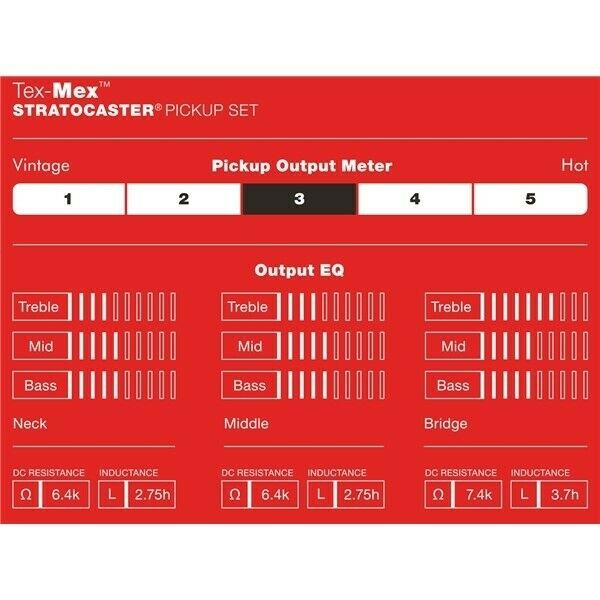
Set Numbers from Box: 0992131000
American Standard
Not the same as American Special and American Performer (2018-2020) but in the same production "line". In fact, many base US Fender Stratocasters Models to come from the same line (I got a American Special that the neck said Highway 1 Line straight from fender). The American Standard pickups are rather tricky because they changed over the years but the standard basically had 2 versions. The modified Tex Mex version and the Fat 50s (see my custom shop, retail page). They do have some very common features that are very identifiable. Early American Standard are actually the same as Tex Mex but the delta version has screws in the bridge pickup. The "Standard" US Stratocasters became the Performer and used different pickups (Yosemite). They changed to Fat 50's for a few years before the performer came out.
NOTE: The BLUE wire for the NECK pickup?!
WIRES: Blue/Black (neck) – Red/Black (middle) – Yellow/Black (bridge)
Numbers: (UP TO 2007) 56205 (neck), 56206 (middle),56207 (bridge) — The official Fender document lists them as 0056205000, 0056206000 and 0056207000. (The left handed versions are the same but are 56707 (for example))
Numbers: (AFTER 2007) – White leads changed to BLACK and colored wires are "hot"
DCR ratings: See Tex Mex
Middle Pickup is RWRP
Special Features: Some Bridge pickups have SCREWS in them. Those are HOT Bridge pickups and are used in the DELTA release.)
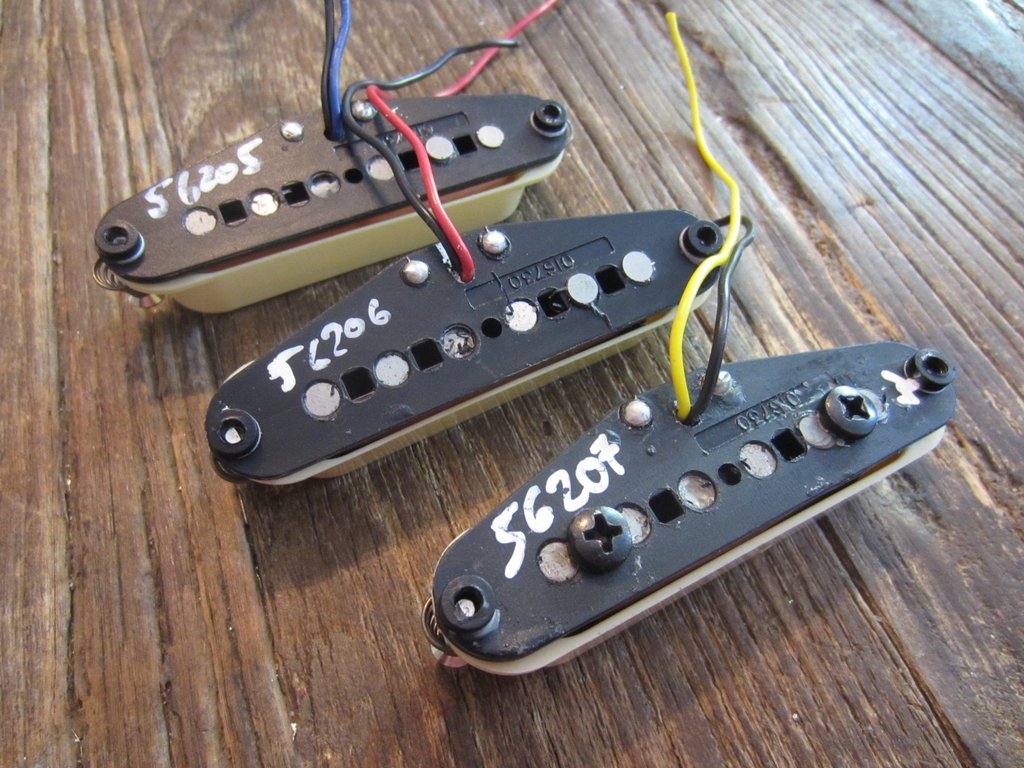

NOTE: The pickup bobbin is NOT a good identifier because Fender used that bobbin on many different pickups.
Measured: American Standard Pickups – See Tex Mex for Measurements. The DELTA version of the bridge has the same reading but has screws in it, it responds slightly hotter than the stock bridge version.
HIGHWAY 1 (2001-2005) AKA 70's
Highway 1 has had different pickups through the years, the early one had lower value pickups that are unusually wired from finish to start instead of start to finish!! Often they are still connected with white "HOT" when they are actually "Black" Hot. The later ones are start to finish as expected not sure which year this changed.
The wires are all Black and White. The DCR for them is about DCR: 5.8K-6.1K; the same as the American Standard and the neck and bridge are the same. There appears to be a lot of variance on the DCR which no values having a dominate value. There are NO identifiable marks on them except the typical bobbin number. The poles are FLAT (not beveled) and Staggered. More vintage tone than the later ones with lower output.
If you get a pickup with same values and all white and black wires, this is potentially a Highway one but could also be a 70s pickup.
These pickups are another one of those "unseen hero's" in Fender pickups. They also showed up with a screw in the bridge as DELTA pickups on AM Standard Strats before they switched to Fat 50s.
- Staggered
- Not Beveled
- Alnico 3
- Black and White (with White as the start – ie: Black is "Hot") Plastic Wire
- Early ones have a much lower DCR (around 6K ish, later ones are much hotter
- These have a more vintage tone
- Note: These showed up later as Classic 70s pickups after 2006
- Real Measurements: (see pick) and 6.1K (2003) – All the same (roughly)
- Inductance about 2.3H
- These were never sold in a retail package.
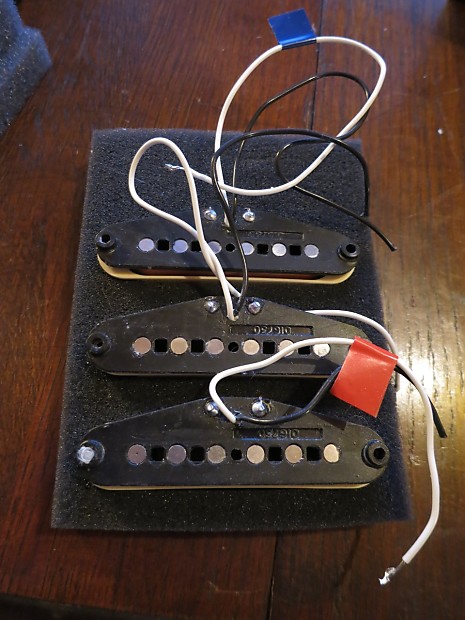
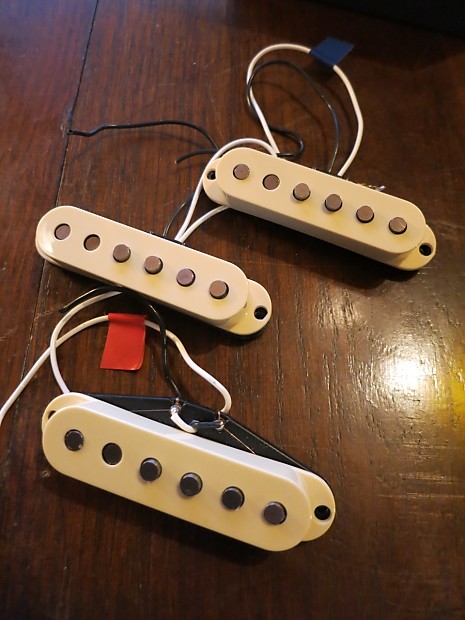
LATER HIGHWAY ONE PICKUPS after 2005-2006
(roughly 2005 on till the AM Special came out in 2011)
Some later Highway 1 Strats have number on them 72706, 72707, 72078 then came later in the 2000's and the DCR was crazy high and can have a wide tolerance range (about 1.5K variation). Very unusual for AM stock pickups. These are ANICO 3. ALSO they are NOT Staggered. Further, they have colored wires on the as shown below. Not vintage tones at all.
- Lots of variance of DCR, from about 10.6K to 12.1K
- Center pickup has Red and Black
- Normal start and finish (black is start and "ground")
- Not Staggered
- Alnico 3
One of them: Neck – 11.13k Middle – 12.13kBridge – 12.01k
Another one: Neck 10.6 K, Middle 11.7 K, Bridge 11.7 K
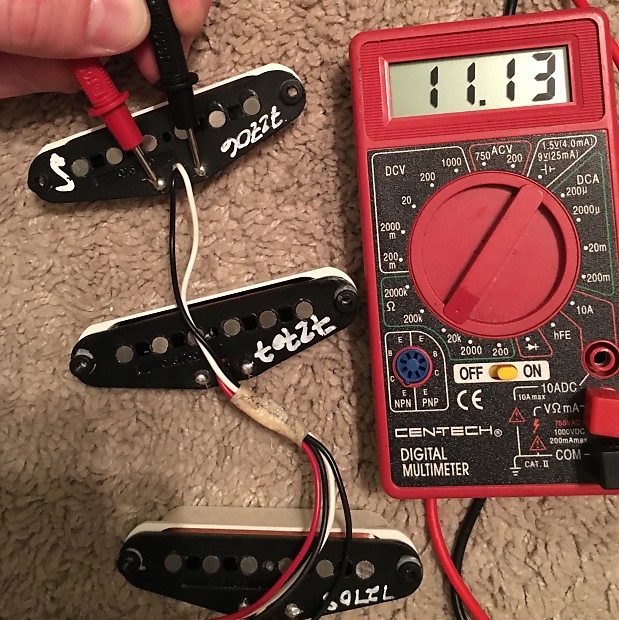
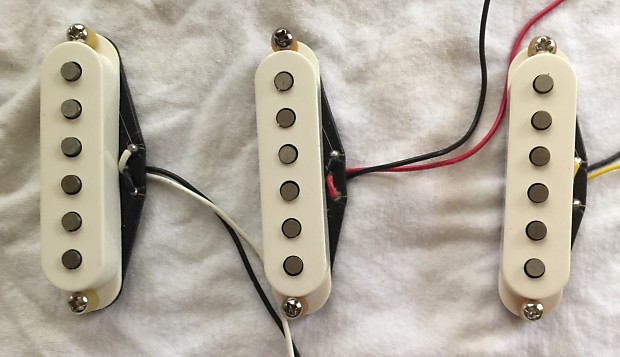
YOSEMITE
These were released on the original Performer Stratocasters. They are unusual in that the use Anico II and Alnico 4. They were kind of a first run for the "Tim Shaw" series. Slightly hotter as you move to the bridge. They have more variance between the position that some of the vintage series which use the same pickup for each position. These always read slightly higher than the advertised value. The change in the inductance is interesting, it means there quite a bit of Frequency peak resonance difference between the pickups.
- 8.1k (neck) – Real measurement – 2.8H
- 8.8K (middle) – Real measurement – 3.1H
- 9.2K (bridge) – Real measurement – 3.65H
- Wires: Neck (Black White), Middle (Yellow Black) Reverse Wound, Bridge (Red Black)
- Available NOS
- Roughly $129 or more New and around $95-110 used.
- RWRP Middle for True Humbucking
$129 New
Fender Information:
- Plain enamel-coated wire
- Reverse-wound/reverse-polarity (RWRP) middle pickup
- Flat-magnet height stagger
- DC Resistance/Magnet Type:
- Neck: 7.8KΩ/alnico 4
- Middle: 8.5KΩ/alnico 4
- Bridge: 8.9KΩ/alnico 2
- Includes installation hardware

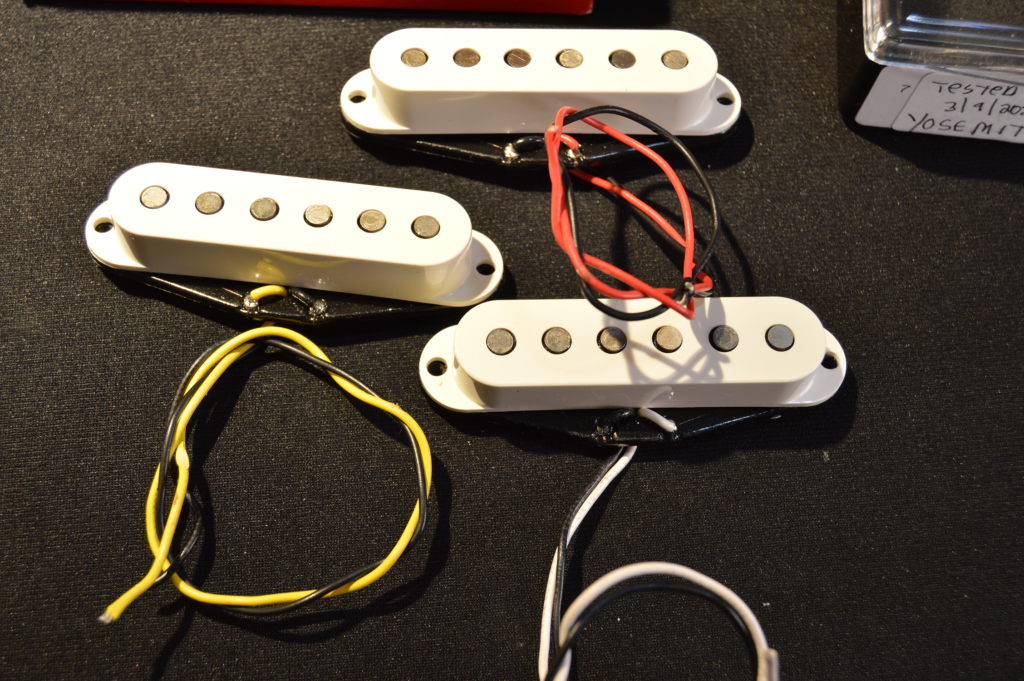
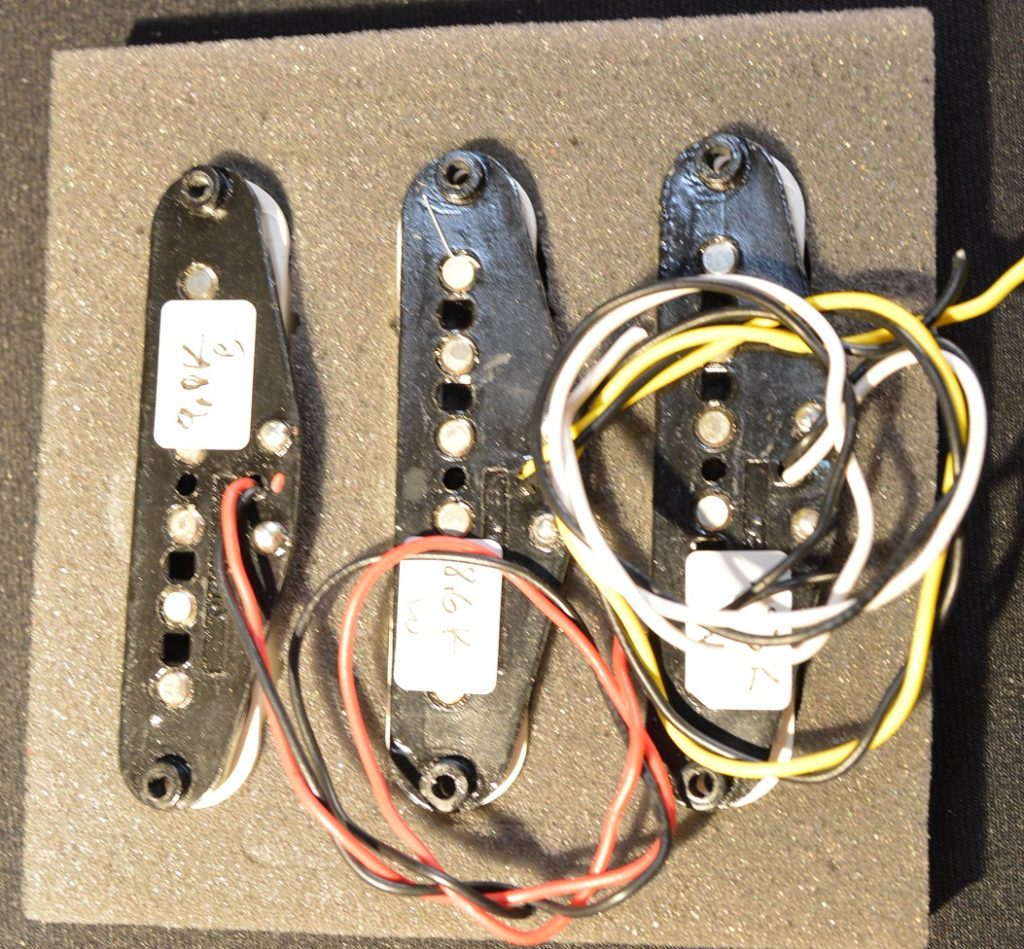
V-MOD
V-MOD pickups are Tim Shaw designed (you know him right? oh, well anyway) they were released on the first PROFESSIONAL I Stratocaster. These are actually really good pickups maybe not as good as the later V-Mod II version.
They do use different magnets for different positions just like the Noiseless N3 models do.
Identifying marks: Red lines through the different poles on the bottoms. Red/Blue/White Hot wires -Black are "negative, return"
- Type:Single-coil
- Active/Passive:Passive
- Magnet Materials Used:Alnico II, III, V
- DC Resistance:6.7k (bridge), 6.7k (middle), 6.4k (neck)
- Inductance: Neck: 2.76 Henries, middle: 2.74 Henries, bridge: 2.8 Henries
- Stock Covering: Aged White
- Manufacturer Part Number:0992266000
- Response: Neck (5,5,5) – Middle (5,5,6) – Bridge (5,5,7) – (Bass, Mid, Treble)
- Power Output: 3 out of 5
- Released On: Fender Professional I Stratocaster
- Retail: $159 to $199 (full retail) – Used: typical $115 +/- range depending on condition.
- Available: NOS and Used
- Beveled and Staggered Poles
- Black Bottom
- Magnet type per pickup: Neck: Alnico 3 and 2; Middle: Alnico 5 and 2, Bridge: Alnico 5 beveled, staggered
- RWRP Middle Pickup
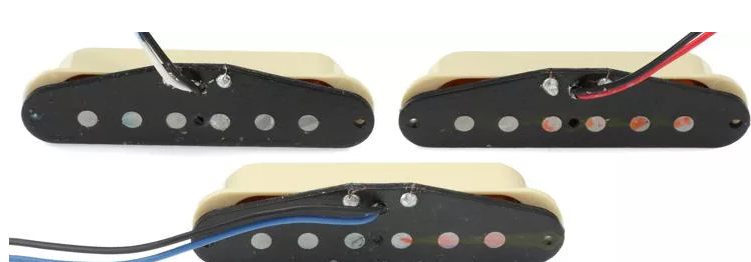
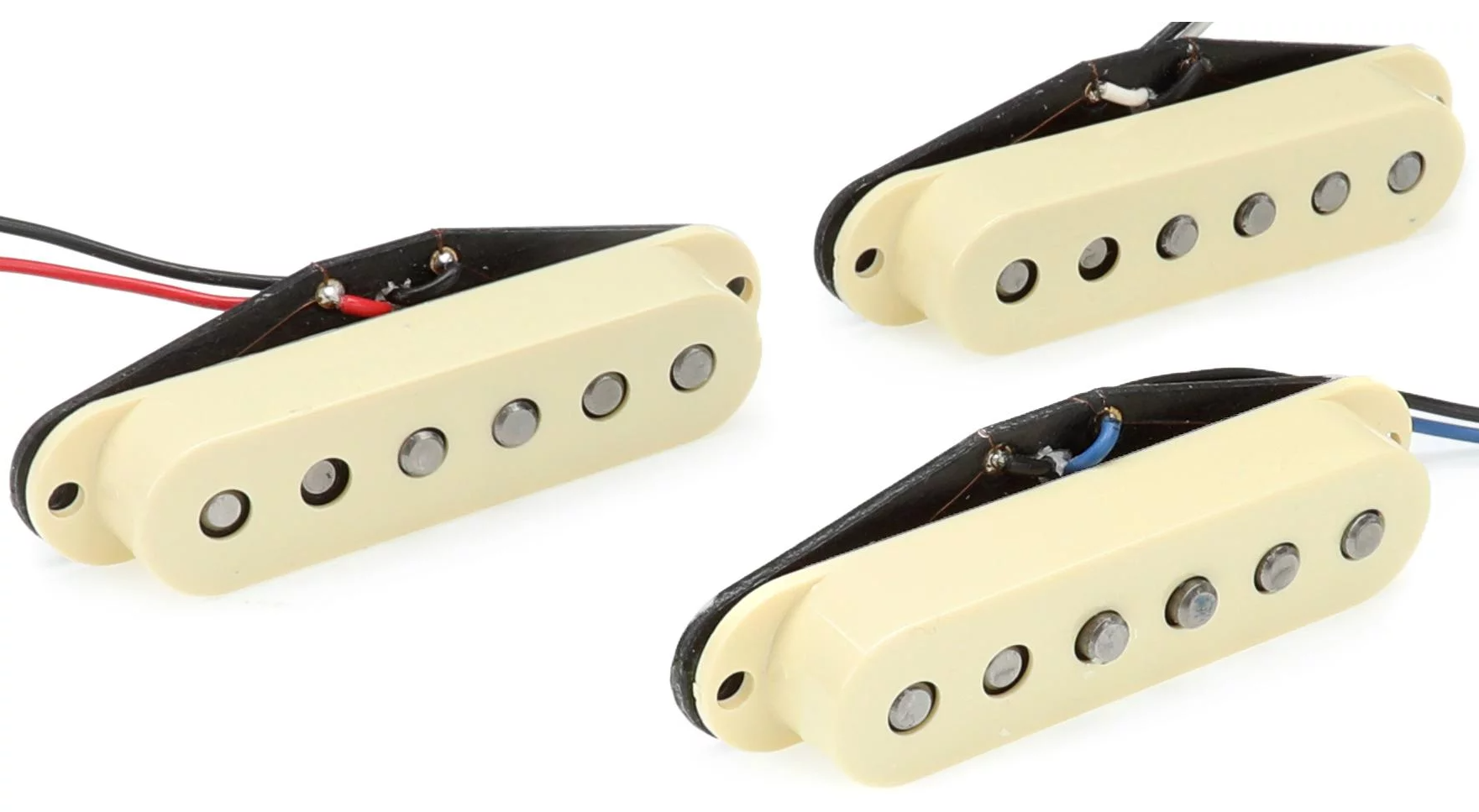
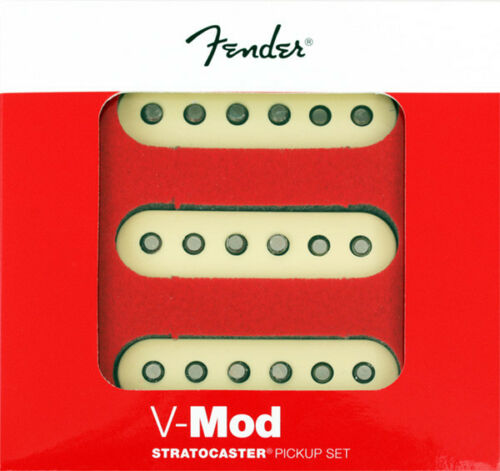
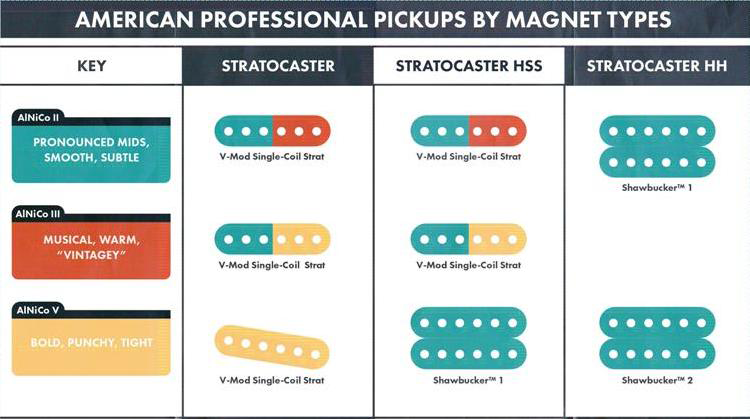
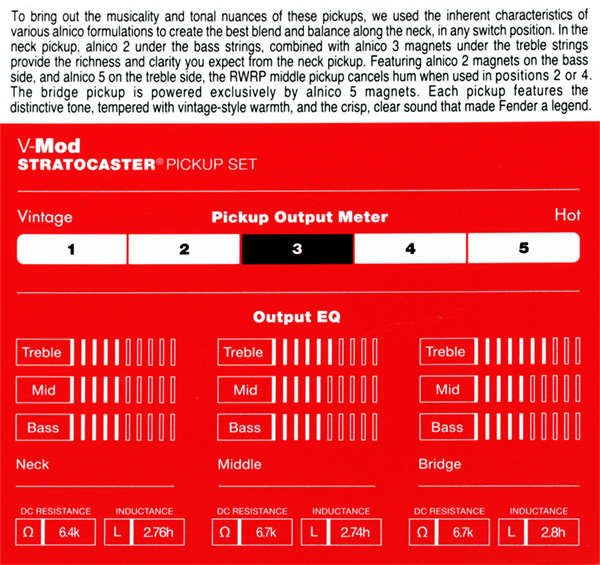
V-MOD II
I recently obtained a couple of sets of these and they are high output, impressive pickups. Overall I give them a 2 thumbs up!! I got my 2nd set and included measurements of those.
Updated: 2022.05.19
Once again, a 2nd child of Tim Shaw (of Styx Fame) for Fender
- V-Mod II Stratocaster single-coil pickups
- HSS Humbucker: Double Tap bridge pickup on HSS versions
- Model appeared on: Fender Professional II Stratocaster
- Availability: Somewhat rare used. Not available retail yet.
- (Values up adjusted slightly by .1K because, measured with volume on full) Bridge 6.3K, Middle 6.4K, Neck 6.7K
- Measured Values on 2nd set: Bridge (6.3K 2.8H) – Middle (6.3K – 2.9H) – Neck (6.2K 3H) – almost the same across the board.
- Beveled
- Staggered
- Mix of Magnetic Types: Alnico 2, 3 and 5 (neck to middle) – SEE V-MOD I – I can't find supporting documentation on this but expect it to be the same as V-Mod I – Only the windings have changed.
- Gray Bottoms
- No real distinquishing marks except the bottom of the poles have been market with a marker.
- Wire Colors: Neck (White/Black) – Middle (Blue/Black) – Bridge (Red/Black)
- Middle Pickup is RWRP 😉
Notable difference between I and II versions – The V-Mod II have more inductance and less K values than the V-Mod I which make them sound "more classic strat" sounding and less dark because it shifts the freq notch higher. The are also more balanced across the pickups.
Public Opinion: These come in HIGHER on the classic chime scale so if you prefer that these are the pickups for you. In general this are slightly more popular than the V-Mod I

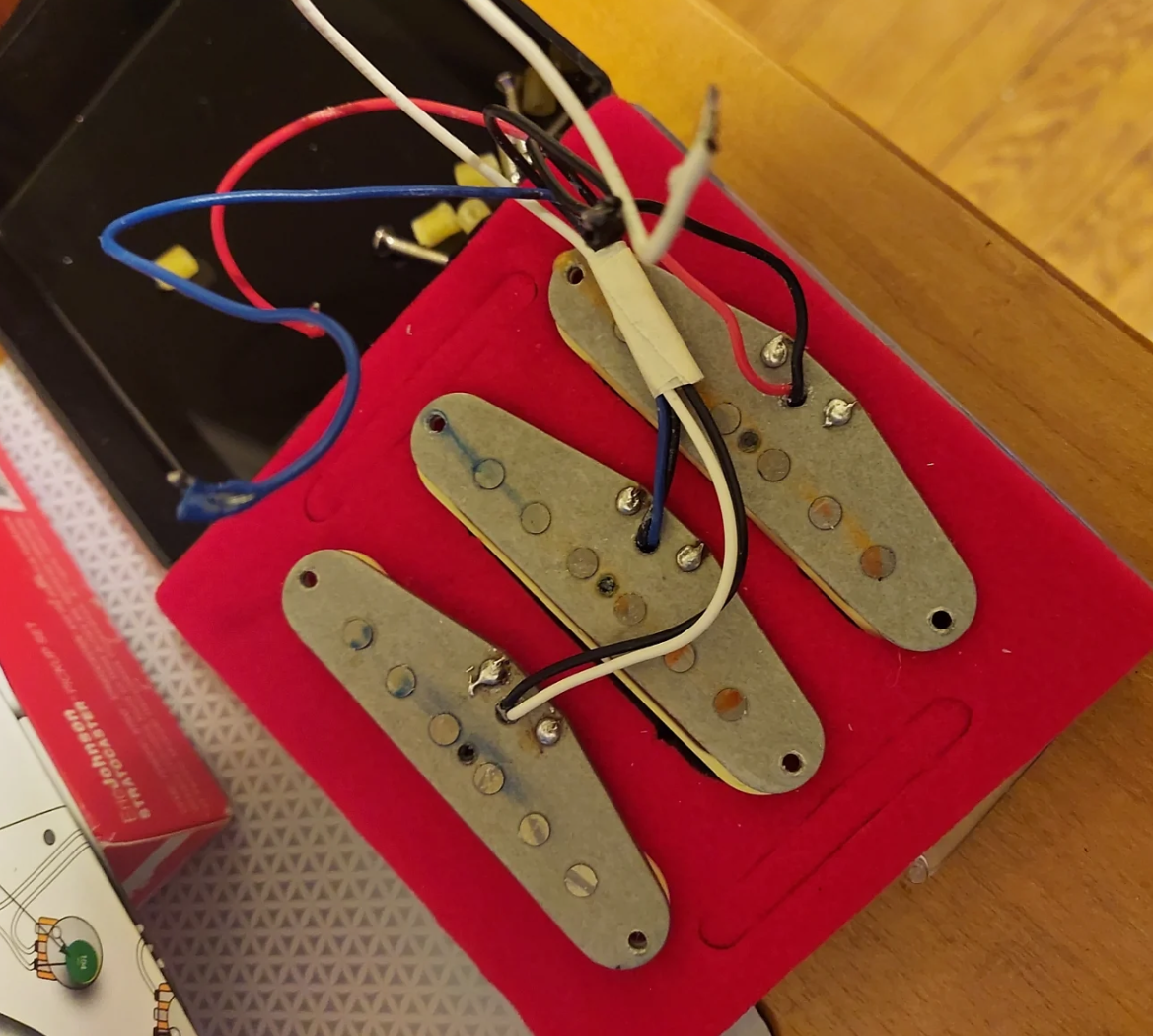
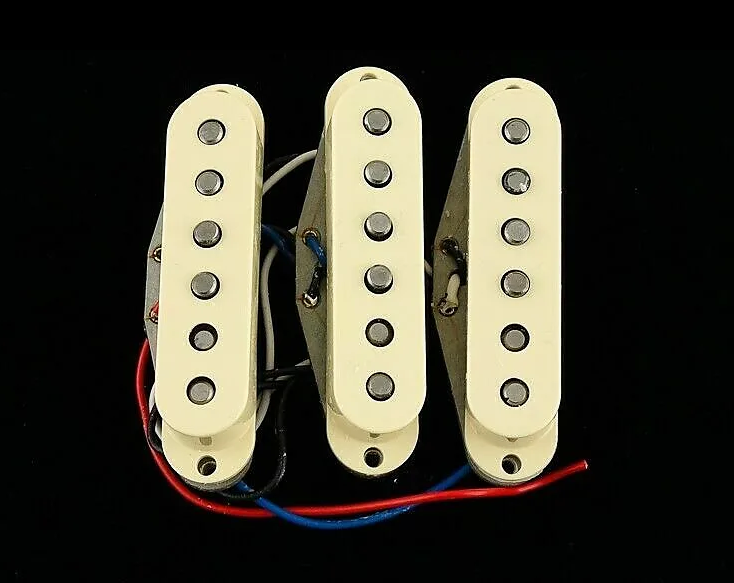
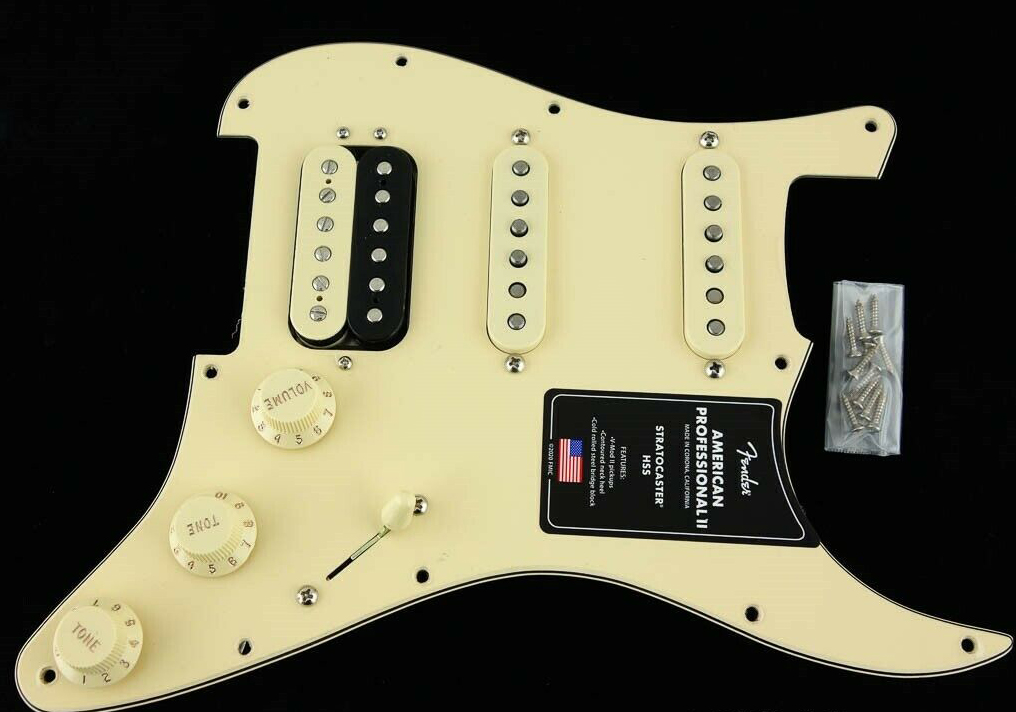
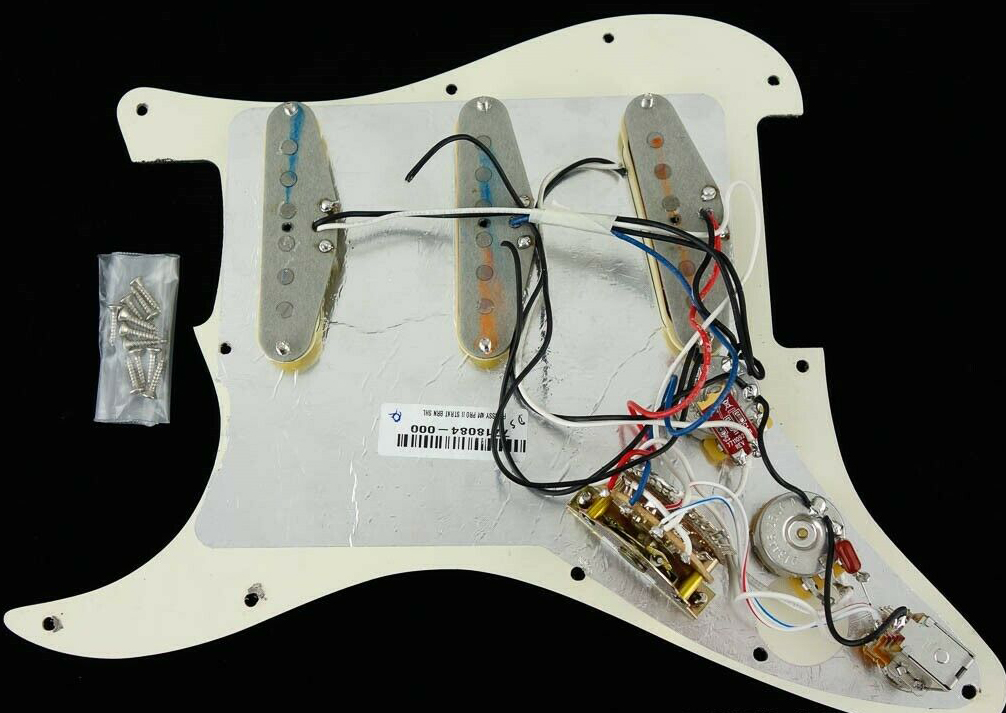
OTHER NOTES
Am. series or standards-plastic flatware. Mid 80's and up (Standard NAMM intro 1987 TBX) to the delta tone, red middle pup wire, blue neck and bridge- whites to the switch.
Source: https://stratocasterdesign.com/index.php/pickup-information/fender-single-coil-pickups/
0 Response to "Fender Single Coil Pickups Red White Blue Dot"
Post a Comment